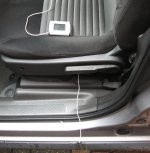- Joined
- Apr 23, 2011
- Messages
- 105
- Points
- 19
Concerning a Fiat Croma Dynamic 1,9 Multijet 16V built 2008
For I wanted to know when a regen took place I studied the fuel consumption figures on the dashboard. Unfortunately this figures are very difficult to read due to theire size, especialy during daytime with the lights on (the latter I prefer). Bending forward to decipher the displayed text, is to my humble opinion, a risky undertaking.
Furthermore it's impossible to show the fuel consumption figures when using the navigation system, and in addition, driving with a laptop on your knees is far from comfortable.
To make things better visible and less dangerous I decided to install a thermometer showing the ingreased temperature during a regen. The only one in my possession was a digital in/out home thermometer with a range from minus 50 to plus 60 degrees Celcius. The sensor for the outside temperature was connected to this instrument with a thiny cable from about 2 meter.

The expected temperature during a regen is about 640 degrees C. To prevent the sensor from melting down, it is mounted about 20 cm from the exhaust pipe and 1 meter downstream the DPF housing, in a spare muffler suspension ring (pn 90466668), slided on a free exhaust bracket. A makeshift arrangement was made for I was not convinced of a positive result.

The displayed temperature during driving is 10 degrees Celsius above the ambient temperature, it ingreases a bit with the speed of the car. Driving in town gives about the same result, some 10 till 12 degrees above the environmental temperature, all the readings turns out to be predictable and stable. A higher outside temperature results in a higher thermometer reading.
The previous months the average value of the readings was around 14 degrees, after it went up several times to 20, I expected a regen to be happened. After checking with ECU scan, it proved to be right.

Hope to can lay my hands on a wireless device with acoustic warning signal in the near future.
Regards
Vento
For I wanted to know when a regen took place I studied the fuel consumption figures on the dashboard. Unfortunately this figures are very difficult to read due to theire size, especialy during daytime with the lights on (the latter I prefer). Bending forward to decipher the displayed text, is to my humble opinion, a risky undertaking.
Furthermore it's impossible to show the fuel consumption figures when using the navigation system, and in addition, driving with a laptop on your knees is far from comfortable.
To make things better visible and less dangerous I decided to install a thermometer showing the ingreased temperature during a regen. The only one in my possession was a digital in/out home thermometer with a range from minus 50 to plus 60 degrees Celcius. The sensor for the outside temperature was connected to this instrument with a thiny cable from about 2 meter.

The expected temperature during a regen is about 640 degrees C. To prevent the sensor from melting down, it is mounted about 20 cm from the exhaust pipe and 1 meter downstream the DPF housing, in a spare muffler suspension ring (pn 90466668), slided on a free exhaust bracket. A makeshift arrangement was made for I was not convinced of a positive result.

The displayed temperature during driving is 10 degrees Celsius above the ambient temperature, it ingreases a bit with the speed of the car. Driving in town gives about the same result, some 10 till 12 degrees above the environmental temperature, all the readings turns out to be predictable and stable. A higher outside temperature results in a higher thermometer reading.
The previous months the average value of the readings was around 14 degrees, after it went up several times to 20, I expected a regen to be happened. After checking with ECU scan, it proved to be right.

Hope to can lay my hands on a wireless device with acoustic warning signal in the near future.
Regards
Vento

